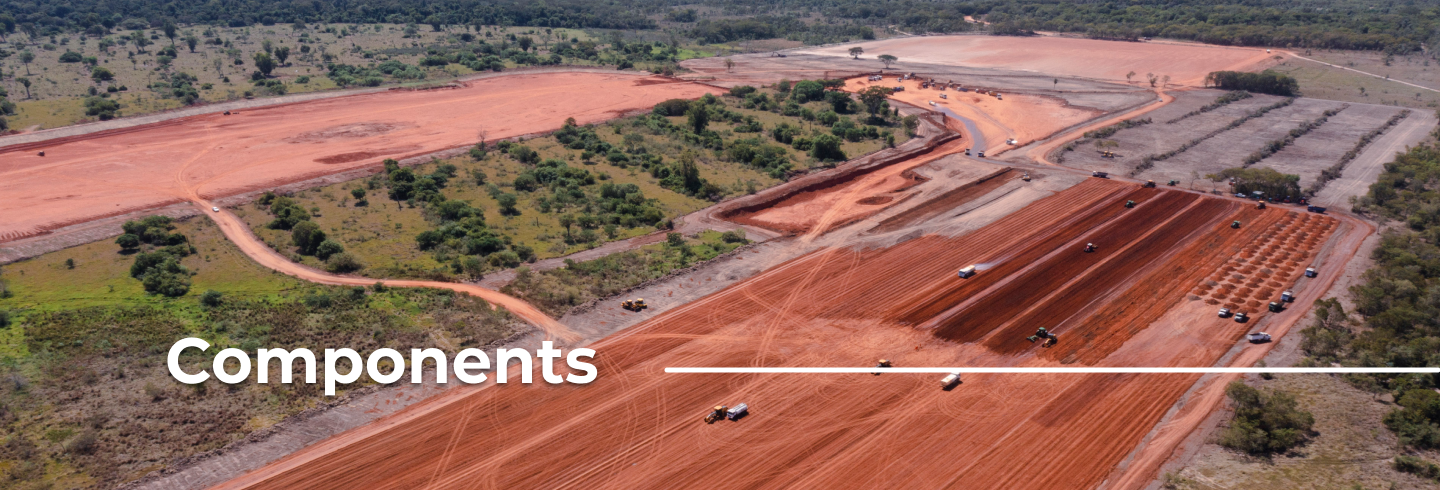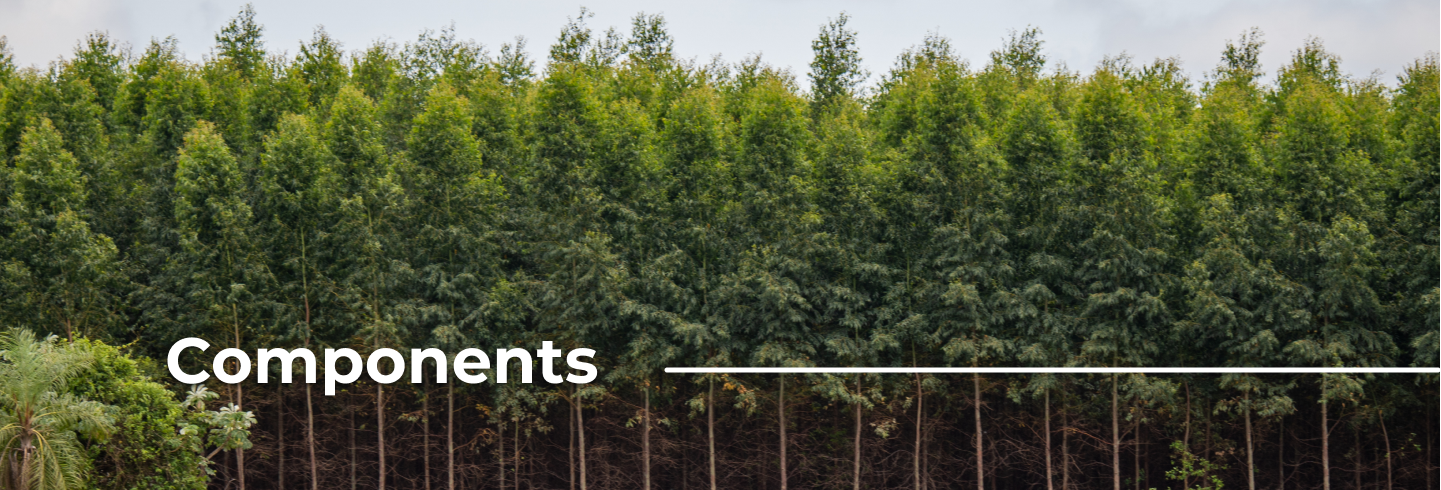


Paracel has three components, where it will build and operate with the highest standards of global sustainability. Below, we explain what each component consists of:
Forestry
The plantations are located in the departments of Concepción and Amambay, at an average distance of 130 km from the factory. In both regions, the climate conditions, as well as the appropriate topography and suitable soils, allow us to plant, cultivate and harvest throughout the year. We currently have approximately 193,000 hectares of company-owned land.
Industrial
Paracel will build and operate its factory with the highest standards of global sustainability. It will be one of the world’s most competitive pulp producers, supplying the world market. The plant is designed for a capacity of 1.8 million tons of bleached eucalyptus kraft pulp (BHKP) per year.
Logistics
The plant is located on the Paraguay River, which runs all the way to the Rio de la Plata. The combination of the extensive river, the year-round uniform climate, and the fact that two-thirds of the roads surrounding the plant are paved, creates an optimal logistics solution for products and materials to and from the plant site.
Paracel will build and operate its factory to the highest standards of global sustainability. It will be one of the most competitive pulp producers in the world, supplying the global market. Today it has more than 193,000 hectares of land, of which almost 100% of the hectares are suitable for plantation, located at an average distance of 130 km from the factory. The plant is designed for a capacity of 1.8 million tons of bleached eucalyptus kraft pulp (BHKP) per year. The region’s rainfall patterns, climatic conditions, flat topography and deep soils make the Concepción region of Paraguay an ideal place to plant, grow and harvest year-round.
The pulp mill will be supplied by internal eucalyptus plantations and local producers. These plantations will produce timber with a growth rate of 35 to 45 m3 per hectare per year and a six-year rotation. The plant is located on the Paraguay River – one of the most important rivers in South America – which runs all the way to the La Plata River. The combination of the extensive river, the year-round uniform climate and the fact that two-thirds of the roads surrounding the plant are paved creates an optimal logistics solution for products and materials to and from the plant site. With these conditions, Paracel will be ready to supply the global market with certified pulp.
Paracel will build and operate its factory to the highest standards of global sustainability. It will be one of the most competitive pulp producers in the world, supplying the global market. Today it has more than 193,000 hectares of land, of which almost 100% of the hectares are suitable for plantation, located at an average distance of 130 km from the factory. The plant is designed for a capacity of 1.8 million tons of bleached eucalyptus kraft pulp (BHKP) per year. The region’s rainfall patterns, climatic conditions, flat topography and deep soils make the Concepción region of Paraguay an ideal place to plant, grow and harvest year-round.
The pulp mill will be supplied by internal eucalyptus plantations and local producers. These plantations will produce timber with a growth rate of 35 to 45 m3 per hectare per year and a six-year rotation. The plant is located on the Paraguay River – one of the most important rivers in South America – which runs all the way to the La Plata River. The combination of the extensive river, the year-round uniform climate and the fact that two-thirds of the roads surrounding the plant are paved creates an optimal logistics solution for products and materials to and from the plant site. With these conditions, Paracel will be ready to supply the global market with certified pulp.
Relevant Data
FAQ
Forestry Component
Eucalyptus «spp» species are used in Paracel, with high yields for cellulose production and adaptability to the climate and soils of the region.
No. Paracel does not plan to use other tree species.
Paracel will source wood from its own plantations, in addition to wood from other local and international producers, to supply raw material for cellulose production.
Yes, an independent producer can produce wood for Paracel. For more information, please contact the following email: fomento.forestal@paracel.com.py
Yes, the Paracel plantations will have a 6 to 7 year cycle from planting to harvest, which means that these areas will be used again for future plantings.
Yes, Paracel is committed to compliance with labor standards, both national and international, and this applies not only to its direct payroll but also to the contractors with whom it works.
Eucalyptus plantations, as well as other crops, use water as part of their growth process. A comparison with other agricultural crops shows a lower consumption per kilogram of biomass produced and kilogram of any product, for example:
Different studies have shown that the water balance of a plantation favors the retention of water in the soil, allowing the buffering of water excesses and deficits, i.e., allowing greater availability of water in the soil. In Paraguay there are already more than 100,000 hectares of eucalyptus plantations and there is no scientific evidence to prove that there is a watercourse that has been drained by these plantations.
Industrial Component
Cellulose is a polysaccharide, that is, it is a carbohydrate similar to sugar and is the main component of the cell wall of plant fibers, a component that provides rigidity and firmness to plants.
Cellulose together with lignin, resins and minerals are the elements that make up wood.
Cellulose accounts for about 50% of all wood, a raw material that is the source of several products we use on a daily basis.
Cellulose is obtained from the tree trunk (at Paracel we will use eucalyptus wood) through an industrial process. It is extracted in the form of pulp, separating it from the lignin, resins and minerals, the latter are used to generate renewable energy (electricity) to supply the industrial plant.
Cellulose is a raw material used in various everyday materials: writing paper, packaging, books and magazines, toilet paper, diapers, tissues and even specialty papers, among others.
Our raw material is plant-based, which allows us to develop biodegradable and recyclable products.
No. Paracel will produce the raw material for paper manufacturing.
No. Paracel will be Paraguay’s first cellulose plant.
It all starts when the eucalyptus tree is carefully planted, cultivated and harvested. After a cycle of approximately seven years, the eucalyptus is cut, peeled and transported to the industrial plant. Bark, leaves and twigs remain in the soil to become organic matter.
Upon arrival at the mill, the wood logs are cut into small pieces, called chips. The purpose of chipping is to reduce the logs to fragments, facilitating the penetration of the cooking liquor from the chemical processes. The preparation of the chips is an important operation, because the final quality of the pulp depends on it.
In the digester, a machine that functions as a «big pressure cooker», the wood, in contact with steam and chemicals, is processed and transformed into cellulose pulp and lignin. In the continuous digesters, wood chips are fed uninterruptedly through special valves, and the products are discharged simultaneously in the same proportion.
Once cooked, the cellulose is washed, cleaned, bleached, dried, pressed and packaged in bales.
In the washing and purification process, impurities are removed; quality is increased; appearance is improved; bleaching costs are reduced and pulp handling is improved.
Bleaching is a sequence of physical and chemical treatments to which the cellulose pulp is subjected to improve some of its properties such as whiteness, cleanliness and chemical purity, promoting a better interaction of the pulp with light. Bleaching makes it possible to increase the paper’s capacity to accept printing or images and, consequently, to increase the usefulness of the papers. This means that during bleaching the pulp is purified, that is, unwanted particles that contaminate the fibers are removed.
In drying, which is the final process, the water is removed from the cellulose. After drying, the pulp sheets are cut and organized into bales, which facilitates transportation.
All wood for the production of Paracel will arrive at the plant cut into logs without bark in order to be split into small chips. Trucks and barges will be used for transportation, depending on the origin and distance from where the wood is located.
Paracel’s industrial plant is designed for a capacity of 1.8 million tons of bleached eucalyptus Kraft cellulose per year.
The Kraft process processes the black liquor and regenerates the cooking chemicals. The recovery boiler is the central point in the Kraft process recovery system and performs the following functions:
Paracel opted for this Kraft process because of the advantages it offers:
It allows to obtain a high level of whiteness in the product and a pulp of high resistance.
The main markets to which Paracel will sell its production will be Asia and Europe.
Yes, the demand for paper for packaging and/or sanitary purposes has shown an increase that is proportional to the growth of the world population. There is also a worldwide trend to replace plastic with paper, since the latter has a shorter decomposition time. For example, if we focus only on China, it is the country with the largest cellulose deficit and needs to secure at least 10 m tons of cellulose until 2025.
The 250kg bales of cellulose will be loaded on barges and transported across the Paraguay River, distributed in 250kg bales, to the maritime terminal that will be located in a port in Uruguay, and from there they will be loaded on overseas ships for their final destination (Asia, Europe, and other countries in the world).
The extreme water levels may eventually affect the company’s operations; therefore, Paracel has a contingency plan for the event of an extreme low water level of the Paraguay River in the Concepción area. This plan contemplates transportation by land to a port south of the city of Asunción, where the cellulose will be loaded onto barges for transport to the ocean terminal.
No. The port of Paracel is designed exclusively for the loading of cellulose and for the reception of raw materials such as wood and inputs for our industrial plant.
Paracel has an internal procedure for requesting and approving visits. For more information, please go to the following link: https://paracel.com.py/solicitud-de-visita/